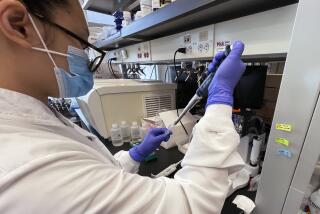Widespread Testing Could Overwhelm Laboratories
- Share via
The sudden deaths of two Washington, D.C., postal workers--neither of whom was previously known to have come in contact with anthrax--has heightened concerns over whether the government is screening enough people for exposure to the bacterium.
It also underscored the government’s limited ability to respond to a widening circle of infection.
Resources in the nation’s capital are so strained from trying to test thousands of postal workers that health department screening sites are staying open until 10 p.m.
And as the number of anthrax infections and exposures mounts, health officials warn that the nation’s laboratories and hospitals are unprepared for widespread screening and detection of anthrax and other rare diseases that might be used by bioterrorists.
Health officials Monday stood by their strategy of screening only people who were in an area where spores have been detected.
But as postal workers lined up by the dozens for testing, some wondered whether their colleagues had to die. Said postal worker Joann Whitfield: “I think they waited too long to get us tested. Bottom line--now two people are dead.”
Tony Bullock, spokesman for Washington Mayor Anthony Williams, said it might have been wiser to have “begun extensive environmental testing and individual swabbing earlier” at the Washington central postal facility.
Referring to the extensive screening of people at the Capitol, Bullock said: “If the same response had occurred [at the postal center] maybe we would have less incidents today. . . . Everybody should have the same level of treatment and response.”
Should much wider screening prove necessary, the nation will be in a bind. Just 100 laboratories nationwide are able to process the test that confirms exposure to anthrax, the vast majority of them strapped county public health laboratories.
“Even with the wealth of money we’re throwing at the problem right now we haven’t done that well” in preparing to detect, treat and prevent illness from bioterrorism--or even from other causes, said Dr. Ward Casscells of the University of Texas Health Science Center in Houston.
If thousands of people needed to be tested in Southern California, “we would be absolutely overwhelmed,” said Los Angeles County public health chief Dr. Jonathan Fielding. “We would not be able to do it.”
Testing for smallpox is even more difficult than testing for anthrax because it is caused by a virus and is difficult to grow in a lab, and because doctors and lab technicians are unfamiliar with it.
Moreover, the public health system lacks the most fundamental tools for detecting rare diseases, experts say. Nearly half of all hospitals do not have the computer systems that would allow epidemiologists to share information about incidents of rare conditions.
“This is a darker day than we were set up to deal with,” said Dr. Linda Rosenstock, dean of the UCLA School of Public Health. “Our systems are inadequate to do surveillance, to do detection and to do follow-up.”
Hospitals report unusual illnesses to the federal government, but the information is collated only once a month; lives could be lost in the meantime.
“We do not have a real-time accumulation of sporadic illnesses,” said Casscells. “It would be impossible to pick up a pattern of Ebola or yellow fever or other conditions that we hardly ever see.”
In the case of anthrax, the CDC is seeking to conserve resources and limit hysteria.
In part because of the difficulty of screening large numbers, the agency recommends that instead of testing people who might be exposed, public health officials should simply treat them with antibiotics--a course that has its own perils.
The CDC has issued strict guidelines to public health labs, telling them to test only patients who have been exposed to a known source of anthrax spores.
But that raises questions about what to do when the exposure is less certain.
One of the two postal workers who died had come to a suburban Maryland hospital Sunday after he fainted in church. He was not screened for anthrax--not at work and not when he arrived at the hospital, where doctors were unaware that he was a postal worker. After a chest X-ray came back normal, he was treated for flu and sent home.
Dr. Venkat Mani, chief of infectious diseases at Southern Maryland Hospital, who treated the man for probable anthrax the following day, said it killed him so quickly that testing might not have helped.
“If we did a nasal culture swab on him two days ago and it was positive, would the outcome have been any different?” Mani asked. “It’s all speculative at this point.” The postal workers’ deaths raise the question of how widely the government should cast its net in search of anthrax. As scares mount, the demand for testing is sure to rise.
Kaiser Permanente’s Northern California offices received between 200 and 300 calls in a two-day period from patients who wanted anthrax tests.
UCLA reports 20 to 30 test seekers a day are calling, and local law enforcement agencies have received hundreds of calls.
On Sunday, public health officials in Washington tested 1,000 postal workers. On Monday, officials expected to test 2,000 more.
If testing were to be carried out on a massive scale, there could be enormous problems with accuracy, said Dr. Michael S. Ascher, lead medical officer for bioterrorism for the state of California.
For example, the blood test to see whether a person has developed antibodies to anthrax is so sensitive that it probably would turn up a high percentage of false positives. The nasal swabs might turn up false negatives, which could lull people who are ill into thinking they are safe, he said.
The problems with anthrax screening also raise questions about what will happen if other bioterrorist agents surface. In the case of smallpox, the CDC is likewise not planning to test or screen, but it will vaccinate people who have had close contact with someone who is ill.
In any case, experts say, improved screening is just one step toward thwarting bioterrorist threats, and it won’t be possible to test everyone.
“I think they will probably broaden the testing,” said Dr. Ruth Greenblatt, professor of medicine and epidemiology at UC San Diego. “But if we try to blanket everybody, we’re going to spend a huge amount of resources and not get very far.”
*
Times wire services were used in compiling this report.
More to Read
Sign up for Essential California
The most important California stories and recommendations in your inbox every morning.
You may occasionally receive promotional content from the Los Angeles Times.










